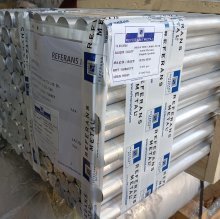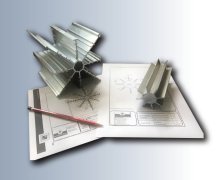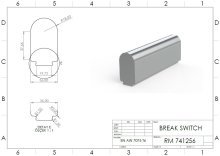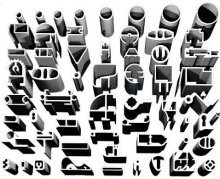



1050
L-3051 / Al99.5 / 1050 / H18
| Chemical Properties | % Value |
| Silicon (Si) | 0,50 - 0,90 |
| Manganese (Mn) | 0,00 - 0,50 |
| Magnesium (Mg) | 0,20 - 0,80 |
| Copper (Cu) | 0,00 - 0,50 |
| Titanium (Ti) | 0,00 - 0,30 |
| Iron (Fe) | 0,00 - 0,40 |
| Zinc (Zn) | 0,00 - 0,50 |
| Aluminium (Al) | Balance |
| Physical Properties | Value |
| Density | 2.705 g/cm³ |
| Melting Point | 646 °C |
| Thermal Expansion | 22.8 µm/m.°C |
| Modulus of Elasticity | 68 GPa |
| Thermal Conductivity | 155 W/m.K |
| Electrical Resistivity | 61% IACS |
| Mechanical Properties | Value |
| Proof Strength | 145 MPa |
| Yield Strength | 160 MPa |
| Shear Strength | 83.0 MPa |
| Elongation A50 mm | 7.0 % |
| Hardness | 43 HB |
The 1050 H18 aluminum alloy is known for its excellent machinability, good corrosion resistance, and low mechanical strength. The H18 temper represents a more strengthened form of the alloy, providing it with medium durability. These properties make 1050 H18 ideal for applications in electrical transmission, heat transfer, decorative uses, and light-duty industrial applications. Additionally, 1050 H18 aluminum is suitable for anodizing, which enhances its surface appearance while increasing its corrosion resistance, making it suitable for long-term outdoor use.
In terms of weldability, 1050 H18 aluminum alloy can be easily welded. Its low hardness makes the welding process straightforward and ensures reliable weld connections. However, proper welding techniques and heat treatment must be applied to achieve the best results. Regarding bending, 1050 H18 aluminum is highly flexible and can be easily bent and shaped. This makes it ideal for various forming processes and enhances its versatility in applications.
The corrosion resistance of 1050 H18 is excellent, especially in atmospheric conditions, and it provides good resistance to corrosive environments such as seawater. This makes 1050 H18 ideal for use in maritime and outdoor structural applications. However, 1050 H18 aluminum alloy may not perform well in high-vibration environments due to its lower mechanical strength, which makes it less suitable for dynamic applications where more robust alloys are required.
The advantages of 1050 H18 aluminum alloy include high machinability, anodizing compatibility, corrosion resistance, and weldability. However, its low mechanical strength may limit its use in applications that require high load-bearing capacity. Additionally, its performance in high-vibration environments is limited. Despite these drawbacks, 1050 H18 is an excellent choice for lightweight structures and aesthetic applications.
Choosing Factors for 1050 H18
- Strength: Average
- Machining: Weak
- Weldability: Very good
- Formability: Okay
- Corrosion Resistance: Very good
- Heat Treating: Yes
Some Well-Known Applications for 1050 H18
It is used in pyrotechnic equipment, architectural applications,
Cable coverings in the construction industry,
And also as a component of insulation boards.
- Plate
| Mechanical Properties | |||
| Thickness (mm) | Proof Strength (Min.) | Yield Strength (Min.) | Elongation A50 mm % |
| Over 0.4 up to & incl. 0.8 | 370 MPa | 430 MPa | %6 |
| Over 0.8 up to & incl. 1.6 | 380 MPa | 440 MPa | %7 |
| Over 1,6 up to & incl. 6,0 | 390 MPa | 440 MPa | %7 |

 Калькулятор Веса
Калькулятор Веса

